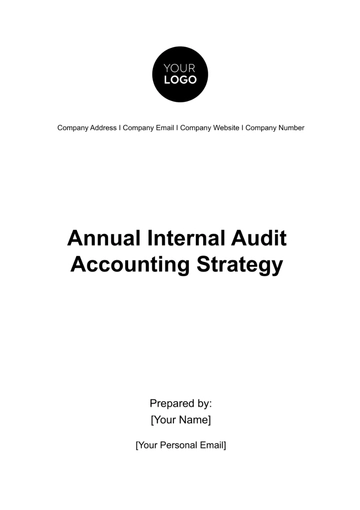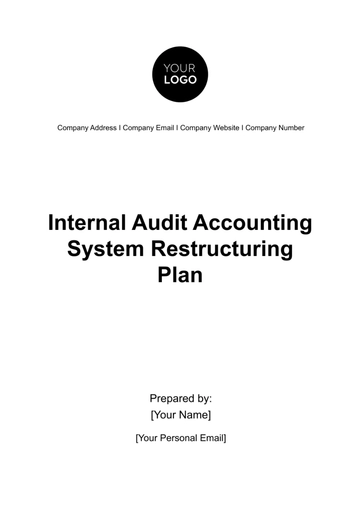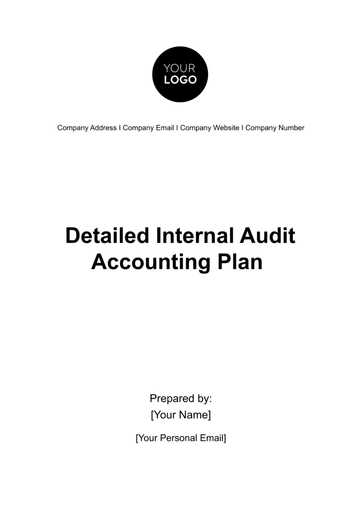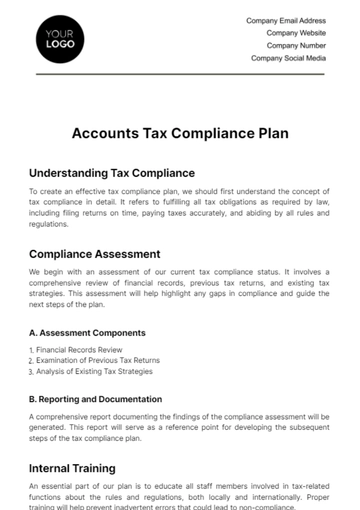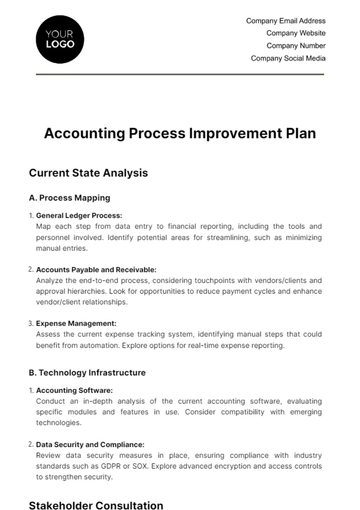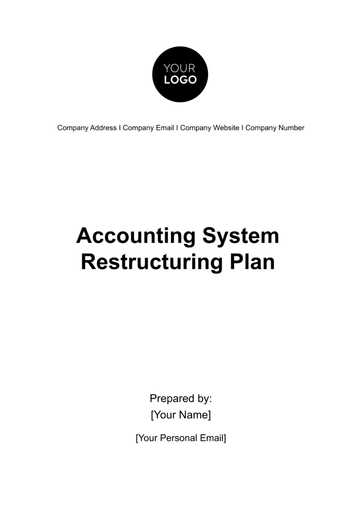Free Accounting Expenditure Approval Plan

I. Introduction
A. Background and Purpose
This Expenditure Approval Plan outlines the procedures and guidelines for the approval of expenditures within [Your Company Name]. The purpose is to ensure efficient financial management, compliance with internal policies and external regulations, and transparent decision-making in the allocation of resources.
B. Scope
This particular plan is applicable across all the departments and cost centers that exist within the organization. The range of expenditures that are covered under this plan are not limited to, but indeed include operational expenses, which pertain to the day-to-day functioning of the business, capital expenditures in the form of investments in business improvements or expansions, and costs that are related to personnel, such as wages, training, and benefits.
C. Authority
The Chief Financial Officer (CFO) is responsible for overseeing the expenditure approval process. The authority for expenditure approvals is delegated to departmental managers based on specified levels.
II. Budget Allocation and Limits
A. Annual Budgeting Process
The organization's annual budget is prepared collaboratively by departmental managers and the finance team. The budget reflects the strategic goals and financial priorities of the organization.
B. Budgetary Limits
Each department and project is allocated a budget, and departmental managers are responsible for managing their expenditures within the allocated limits. Requests for adjustments to budgetary allocations must be submitted in accordance with the procedures outlined in Section IV.
III. Authorization Levels and Workflows
A. Authorization Matrix
Authorization levels are categorized based on the amount of expenditure. The matrix outlines the levels of authority and the corresponding individuals responsible for approvals at each level.
B. Approval Workflows
The process of requesting expenditures adheres to a specific, predetermined workflow. This workflow initiates with the departmental manager who makes the initial review and decision about the request. Afterwards, depending upon the specific nature of the request, it may advance through subsequent approval levels. The procedure at these additional approval levels is also distinctly outlined ahead of time, and may be required based on a variety of factors such as the amount of the expenditure or the department it will impact. Each person tasked with approving a request at any given stage of the workflow has a role that is clearly defined. This means that they have distinct responsibilities that they need to adhere to when considering and approving or denying expenditure requests.
C. Emergency or Expedited Approvals
In exceptional circumstances requiring immediate action, designated individuals have the authority to approve emergency or expedited expenditures. Criteria for qualifying expenditures and the process for obtaining approvals are outlined in the plan.
IV. Documentation Requirements
A. Required Documentation
Expenditure requests must include detailed documentation, such as invoices, receipts, and justifications, to support the requested amount. Proper record-keeping is essential for audit purposes.
V. Compliance and Policy Adherence
A. Internal Policies
It is required that all expenditures that are made must adhere strictly to the internal policies and procedures that our organization has set in place. In addition, in every operation that is carried out, it is mandatory to be in compliance with any regulations set forth by our industry and also to comply strictly with the legal requirements that have been laid down by the law.
B. Fraud Prevention
There are measures and precautions already implemented in our system so we can prevent activities that are fraudulent in nature. If there are any suspicious activities which you suspect could be fraudulent, it's absolutely crucial that you report them through the channels that have been previously established for this very purpose.
VI. Audit Trails and Monitoring
A. Audit Trail Mechanisms
Technological tools are utilized for the purpose of following and documenting all stages of the process of approval for expenditures. This is done to sustain a proper record-keeping system. To ensure transparency and accountability in this overall process, regular evaluations or reviews of the recorded audit trail are implemented and meticulously carried out.
B. Monitoring Expenditures
We have structured a set of tools and processes that are effectively in place to monitor and keep a track of actual expenditures in reference to the approved budgets. We have put in place analysis and reporting mechanisms which are instrumental in identifying the spending patterns and understanding the financial flow. This system is highly beneficial as it assists in taking the necessary corrective actions if any discrepancy or anomaly in the spending pattern is observed, thereby ensuring efficient financial management.
VII. Communication Protocols
A. Submission Process
Expenditure requests are submitted through designated communication channels, accompanied by all necessary documentation. Clear guidelines on the information required are provided.
B. Reporting
Regular reports on the status of expenditure approvals are communicated to relevant stakeholders. Approved budgets are shared with departmental managers for implementation.
VIII. Training and Awareness
A. Training Programs
Training sessions are routinely held for the benefit of employees who participate in the approval process for expenditures. These sessions are designed to equip them with necessary skills and knowledge they need to effectively carry out their roles. To further ensure that everyone involved has a clear understanding of the process and their responsibilities, educational materials outlining the plan guidelines are distributed. This approach ensures that everyone is on the same page and can effectively contribute to the smooth operation of the expenditure approval process.
IX. Continuous Improvement
A. Periodic Review
The strategy is regularly subjected to a series of periodic reviews, the purpose of which is to carefully assess and evaluate its effectiveness in achieving the desired targets and objectives. Moreover, feedback and suggestions from various stakeholders who are directly or indirectly impacted by the plan are given substantial consideration in this process. These insights help to provide a more comprehensive understanding of the practical implications of the plan's implementation. Furthermore, there is a provision for making adjustments and modifications in the plan as and when needed, based on the outcomes of these reviews and the feedback received. The primary aim of these adjustments is to enhance the efficiency of the process that approves the expenditures, making it more streamlined and effective in its functioning.
X. Conclusion
A. Acknowledgment of Responsibility
The Chief Financial Officer must be fully aware and completely understand that a certain responsibility attached to overseeing the expenditure approval process within our the company is critical. The CFO obliged to ensure its smooth functioning. Furthermore, it is my strong commitment to continually strive towards the enhancement and improvement of the overall process and to always be in strict accordance with, and adhere to the rules, regulations, and guidelines as specifically outlined in this particular plan of action.
- 100% Customizable, free editor
- Access 1 Million+ Templates, photo’s & graphics
- Download or share as a template
- Click and replace photos, graphics, text, backgrounds
- Resize, crop, AI write & more
- Access advanced editor
Introducing the Accounting Expenditure Approval Plan Template from Template.net! Streamline financial governance effortlessly with this editable and customizable solution. Crafted for precision, it incorporates an intuitive AI Editor Tool for seamless modifications. Elevate your organization's fiscal control with a plan that adapts to your unique needs. Unlock efficiency and compliance in just a few clicks!
You may also like
- Finance Plan
- Construction Plan
- Sales Plan
- Development Plan
- Career Plan
- Budget Plan
- HR Plan
- Education Plan
- Transition Plan
- Work Plan
- Training Plan
- Communication Plan
- Operation Plan
- Health And Safety Plan
- Strategy Plan
- Professional Development Plan
- Advertising Plan
- Risk Management Plan
- Restaurant Plan
- School Plan
- Nursing Home Patient Care Plan
- Nursing Care Plan
- Plan Event
- Startup Plan
- Social Media Plan
- Staffing Plan
- Annual Plan
- Content Plan
- Payment Plan
- Implementation Plan
- Hotel Plan
- Workout Plan
- Accounting Plan
- Campaign Plan
- Essay Plan
- 30 60 90 Day Plan
- Research Plan
- Recruitment Plan
- 90 Day Plan
- Quarterly Plan
- Emergency Plan
- 5 Year Plan
- Gym Plan
- Personal Plan
- IT and Software Plan
- Treatment Plan
- Real Estate Plan
- Law Firm Plan
- Healthcare Plan
- Improvement Plan
- Media Plan
- 5 Year Business Plan
- Learning Plan
- Marketing Campaign Plan
- Travel Agency Plan
- Cleaning Services Plan
- Interior Design Plan
- Performance Plan
- PR Plan
- Birth Plan
- Life Plan
- SEO Plan
- Disaster Recovery Plan
- Continuity Plan
- Launch Plan
- Legal Plan
- Behavior Plan
- Performance Improvement Plan
- Salon Plan
- Security Plan
- Security Management Plan
- Employee Development Plan
- Quality Plan
- Service Improvement Plan
- Growth Plan
- Incident Response Plan
- Basketball Plan
- Emergency Action Plan
- Product Launch Plan
- Spa Plan
- Employee Training Plan
- Data Analysis Plan
- Employee Action Plan
- Territory Plan
- Audit Plan
- Classroom Plan
- Activity Plan
- Parenting Plan
- Care Plan
- Project Execution Plan
- Exercise Plan
- Internship Plan
- Software Development Plan
- Continuous Improvement Plan
- Leave Plan
- 90 Day Sales Plan
- Advertising Agency Plan
- Employee Transition Plan
- Smart Action Plan
- Workplace Safety Plan
- Behavior Change Plan
- Contingency Plan
- Continuity of Operations Plan
- Health Plan
- Quality Control Plan
- Self Plan
- Sports Development Plan
- Change Management Plan
- Ecommerce Plan
- Personal Financial Plan
- Process Improvement Plan
- 30-60-90 Day Sales Plan
- Crisis Management Plan
- Engagement Plan
- Execution Plan
- Pandemic Plan
- Quality Assurance Plan
- Service Continuity Plan
- Agile Project Plan
- Fundraising Plan
- Job Transition Plan
- Asset Maintenance Plan
- Maintenance Plan
- Software Test Plan
- Staff Training and Development Plan
- 3 Year Plan
- Brand Activation Plan
- Release Plan
- Resource Plan
- Risk Mitigation Plan
- Teacher Plan
- 30 60 90 Day Plan for New Manager
- Food Safety Plan
- Food Truck Plan
- Hiring Plan
- Quality Management Plan
- Wellness Plan
- Behavior Intervention Plan
- Bonus Plan
- Investment Plan
- Maternity Leave Plan
- Pandemic Response Plan
- Succession Planning
- Coaching Plan
- Configuration Management Plan
- Remote Work Plan
- Self Care Plan
- Teaching Plan
- 100-Day Plan
- HACCP Plan
- Student Plan
- Sustainability Plan
- 30 60 90 Day Plan for Interview
- Access Plan
- Site Specific Safety Plan


